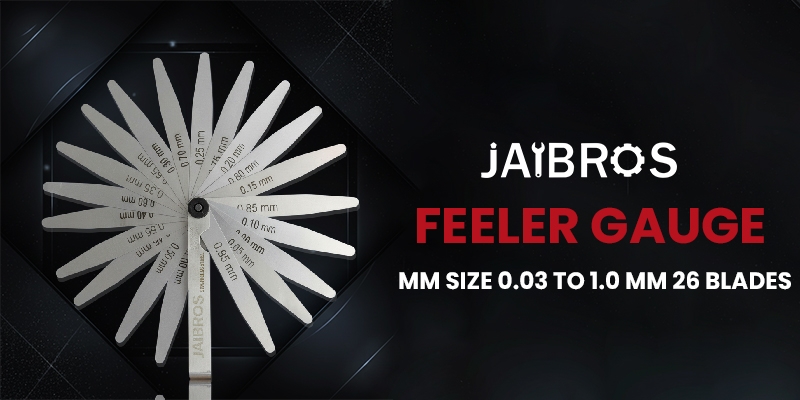Learn the top mistakes technicians make when using a feeler gauge for calibration. Discover tips on sizes, least count, price, and proper measurement techniques.
The Most Frequent Feeler Gauge Mistakes Technicians Should Never Make
Machine calibration demands accuracy, and even a small oversight can affect performance, alignment, and component life. Technicians depend on a feeler gauge to measure gaps precisely, but incorrect handling often leads to inaccurate readings and avoidable mechanical issues. Understanding the common mistakes helps ensure more reliable calibration and long-term machine efficiency.
Calibration isn’t just about inserting a blade into a gap—it’s about choosing the right thickness, understanding the correct technique, and avoiding habits that can damage the machine or the tool.
1. Choosing the Wrong Blade Thickness
One of the biggest mistakes users make is selecting the wrong blade. A blade too thin or too thick gives misleading clearance results. Most technicians refer to a feeler gauge size chart to choose the right blade quickly, but skipping this step often leads to errors.
The feeler gauge size chart helps ensure you’re working with the exact thickness required, especially in tasks where tolerances are extremely tight.
2. Ignoring the Feeler Gauge Least Count
Every precision tool has its limit of accuracy, and this is often explained by the feeler gauge least count. Technicians who ignore this value may assume the tool measures finer than it actually does, leading to incorrect spacing.
Since the feeler gauge least count represents the smallest thickness you can reliably measure, overlooking it means compromising machine calibration quality.
3. Applying Too Much Force During Measurement
A standard mistake is forcing the blade between two components. A feeler gauge should slide with slight resistance. If you push the blade aggressively, two things can happen:
-
You damage the blade by bending or scratching it.
-
You distort the actual gap, leading to false readings.
Always insert the blade gently and let the natural drag determine whether the clearance is correct.
4. Not Using the Correct Unit of Measurement
Many industrial machines specify clearance in millimeters, so selecting blades based on feeler gauge sizes in mm is essential. Choosing the wrong unit results in measurements that don’t match manufacturer recommendations.
For accuracy, always double-check the manual and compare the values with feeler gauge sizes in mm to avoid confusing inch-based readings.
5. Selecting a Poor-Quality Tool Based on Only Price
Some technicians choose their tools purely based on feeler gauge price. While affordability matters, extremely low-cost sets may compromise precision. Blade thickness inconsistency, bending, and corrosion issues are common in cheap tools.
Balancing durability and performance instead of focusing only on feeler gauge price helps ensure better calibration results and longer tool life.
6. Not Cleaning the Blades Before and After Use
Oil, dust, and metal shavings can stick to the blades. Using a feeler gauge without cleaning it may produce incorrect drag and misleading readings. Dirty blades may even scratch delicate machine surfaces.
Wipe blades with a clean cloth before inserting and store them dry to prevent corrosion.
7. Using Only One Blade Instead of Stacking When Needed
Some clearances do not match a single blade thickness. In such cases, technicians need to stack blades. A feeler gauge is designed for blade combination, but many users avoid stacking due to lack of practice. This often leads to approximations instead of precise calibration.
Stacking blades ensures exact measurements and avoids machine inconsistencies.
FAQs
1. Why is a feeler gauge important for calibration?
It measures the clearance between two components, ensuring they align and function correctly during machine operation.
2. How do I know which blade thickness to choose?
Refer to the manufacturer’s manual and consult the feeler gauge size chart to match the exact clearance requirement.
3. What affects the accuracy of a feeler gauge?
Blade quality, cleanliness, and the feeler gauge least count determine how accurately the tool measures small gaps.
4. Are feeler gauges available in different units?
Yes, especially sets based on feeler gauge sizes in mm, which help match most industrial specifications.
5. Does feeler gauge price matter when choosing a tool?
Higher quality often costs more but ensures consistent, reliable readings and long tool life.
Conclusion
Avoiding these common mistakes ensures that your feeler gauge delivers accurate, dependable calibration results every time. Choosing the right blade, understanding measurement limits, and using the proper technique all contribute to better machine performance and reduced mechanical issues.
For professionals seeking durable, precise, and well-engineered measurement tools, Jaibros offers a trusted range of high-quality products designed for industrial accuracy and long-term reliability.


